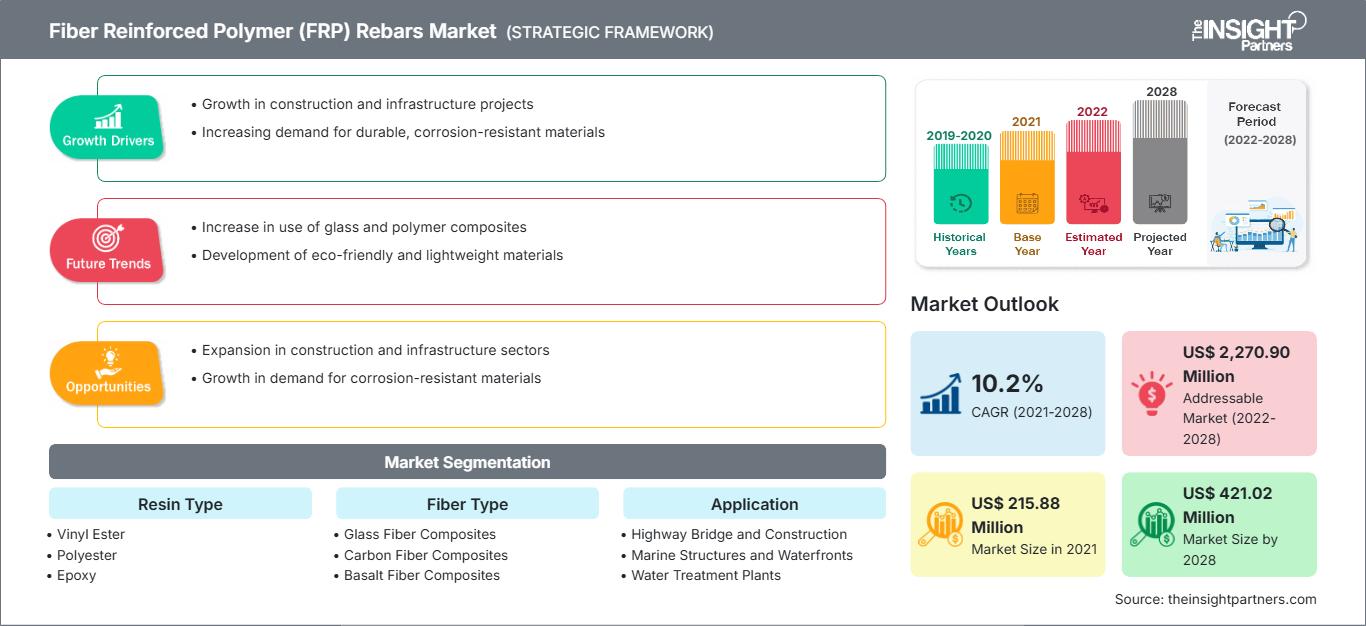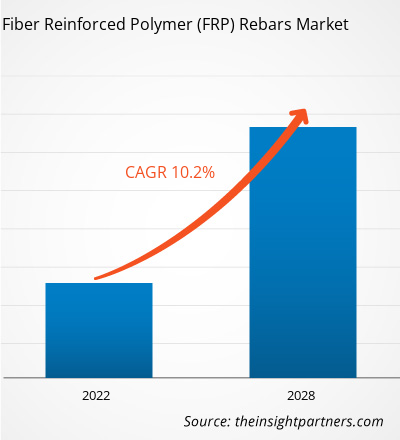纤维增强聚合物 (FRP) 钢筋市场预计将从 2021 年的 2.1588 亿美元增长到 2028 年的 4.2102 亿美元;预计 2022 年至 2028 年的复合年增长率为 10.2%。
由于混凝土抗压强度高而抗拉强度低,因此通常会对其进行强化,以制造出抗拉抗压强度高的建筑材料。由于钢材成本低、强度高、弹性好,这种钢筋通常由钢材制成。然而,钢筋腐蚀可能会使政府和资产所有者在更换或修复老化基础设施的维护成本上损失数十亿美元。目前,用于防止腐蚀的混凝土增强材料替代品很少。例如,一些制造商提供不锈钢钢筋;然而,纤维增强聚合物钢筋可以作为传统钢筋的防腐蚀替代品,用于混凝土加固。这些玻璃钢钢筋由聚合物基质与玻璃纤维、碳纤维或玄武岩纤维组合而成。这些材料不会生锈,比钢材轻得多,不导热,抗拉强度几乎是钢材的四倍。其优异的抗腐蚀性能使纤维增强聚合物成为各种建筑应用的最佳选择,例如挡土墙、桥墩、防波堤、码头、沉箱、甲板、舱壁、桩基、运河、海上平台、游泳池和水族馆。
此外,在电磁敏感应用中,玻璃钢钢筋的玻璃和聚合物绝缘特性不会传输电流、不会引发雷击或干扰附近电气设备的运行。这使得纤维增强聚合物成为铝和铜冶炼厂、机场塔台、核电站、专用军事建筑、电力和电话传输塔、装有电气或电话设备的检修孔以及配备磁共振成像 (MRI) 设备的医院中比钢材更安全的替代品。
自定义此报告以满足您的要求
您将免费获得任何报告的定制,包括本报告的部分内容,或国家级分析、Excel 数据包,以及为初创企业和大学提供超值优惠和折扣
纤维增强聚合物(FRP)钢筋市场: 战略洞察

-
获取本报告的主要市场趋势。这个免费样本将包括数据分析,从市场趋势到估计和预测。
市场洞察
日益增长的建筑活动推动纤维增强聚合物 (FRP) 钢筋市场增长
建筑业是全球经济发展的主要贡献者之一。由于全球各国政府加大对基础设施建设的支持力度,建筑业正在迅速蓬勃发展。例如,印度计划在 2019 年至 2023 年期间通过国家基础设施管道在基础设施上投资 1.4 万亿美元。在该管道中,政府包括了电力、桥梁、水坝、道路和城市基础设施建设等基础设施。由于纤维增强聚合物具有强度高、耐霜冻和除冰盐、安装时间短、交通干扰最小等优势材料特性,因此已成为桥梁结构的宝贵替代建筑材料。各国政府的此类举措预计将推动纤维增强聚合物 (FRP) 钢筋市场的增长。
树脂类型洞察
根据树脂类型,全球纤维增强聚合物 (FRP) 钢筋市场细分为乙烯基酯、聚酯、环氧树脂等。2021 年,乙烯基酯占据了最大的市场份额。乙烯基酯树脂强度高;耐腐蚀、耐燃料、耐化学品或耐蒸汽;并提供机械韧性。它们具有出色的耐久性、耐热性和高拉伸伸长强度。这种树脂可以浸渍短玻璃纤维或碳纤维来生产 FRP 钢筋。大多数纤维增强聚合物钢筋制造商都使用乙烯基酯树脂。乙烯基酯的成本效益促进了该领域的增长。
欧文斯科宁;KODIAC 玻璃纤维钢筋;MARSHALL COMPOSITE TECHNOLOGIES, LLC; TUF-BAR;Armastek USA;Pultron Composites;FiRep Inc.;
PULTRALL, Inc.;Schock Bauteile GmbH;以及 Dextra Group 是全球纤维增强聚合物(FRP) 钢筋市场的主要参与者。领先的参与者采用并购和产品发布等策略来扩大其地域覆盖范围和客户群。例如,Pultron Composites 与沙特阿拉伯领先的石油公司沙特阿美建立了合作伙伴关系,以增加其在沙特阿拉伯的玻璃纤维增强聚合物 (GFRP) 钢筋生产设施。纤维增强聚合物(FRP)钢筋市场区域洞察
The Insight Partners 的分析师已详尽阐述了预测期内影响纤维增强聚合物 (FRP) 钢筋市场的区域趋势和因素。本节还讨论了北美、欧洲、亚太地区、中东和非洲以及南美和中美洲的纤维增强聚合物 (FRP) 钢筋市场细分和地域分布。
纤维增强聚合物(FRP)钢筋市场报告范围
| 报告属性 | 细节 |
|---|---|
| 市场规模 2021 | US$ 215.88 Million |
| 市场规模 2028 | US$ 421.02 Million |
| 全球复合年增长率 (2021 - 2028) | 10.2% |
| 历史数据 | 2019-2020 |
| 预测期 | 2022-2028 |
| 涵盖的领域 |
By 树脂类型
|
| 覆盖地区和国家 |
北美
|
| 市场领导者和主要公司简介 |
|
纤维增强聚合物 (FRP) 钢筋市场参与者密度:了解其对业务动态的影响
纤维增强聚合物 (FRP) 钢筋市场正在快速增长,这得益于终端用户需求的不断增长,而这些需求的驱动因素包括消费者偏好的不断变化、技术进步以及对产品优势的认知度不断提高。随着需求的增长,企业正在扩展产品线,不断创新以满足消费者需求,并抓住新兴趋势,从而进一步推动市场增长。

- 获取 纤维增强聚合物(FRP)钢筋市场 主要参与者概述
报告重点
- 纤维增强聚合物 (FRP) 钢筋行业的发展趋势,帮助参与者制定有效的长期战略
- 公司为确保在发达和发展中市场的增长而采取的业务增长战略
- 2022 年至 2028 年全球纤维增强聚合物 (FRP) 钢筋市场的定量分析
- 对纤维增强聚合物 (FRP) 钢筋的需求进行估计
- 波特分析说明了行业中的买家和供应商预测市场增长的有效性
- 了解竞争激烈的市场形势和对纤维增强聚合物 (FRP) 钢筋的需求的最新发展
- 市场趋势和前景,以及推动和抑制全球纤维增强聚合物 (FRP) 钢筋市场增长的因素
- 了解支撑全球纤维市场商业利益的战略
- 全球纤维增强聚合物 (FRP) 钢筋市场在各个市场节点的规模
- 全球纤维增强聚合物 (FRP) 钢筋市场的详细概述和细分及其行业动态
- 全球纤维增强聚合物 (FRP) 钢筋市场在各个地区的规模及良好的增长机会
《2028 年纤维增强聚合物 (FRP) 钢筋市场分析》是一项针对化学品和材料行业的专业深入研究,重点关注纤维增强聚合物 (FRP) 钢筋市场趋势分析。该报告旨在提供市场概述和详细细分。纤维增强聚合物 (FRP) 钢筋市场分为树脂类型、纤维类型、应用和地域。根据树脂类型,市场细分为乙烯基酯、聚酯、环氧树脂和其他。根据纤维类型,市场细分为玻璃纤维复合材料、碳纤维复合材料和玄武岩纤维复合材料。根据应用,市场细分为公路桥梁及建筑、海洋结构和滨水区、水处理厂等。根据地域分布,市场分为五个主要区域——北美、欧洲、亚太地区、中东和非洲以及南美和中美洲。2021年,北美占据了纤维增强聚合物 (FRP) 钢筋市场的主导地位。然而,预计在预测期内,亚太地区将实现最高的复合年增长率。
- 历史分析(2 年)、基准年、预测(7 年)及复合年增长率
- PEST和SWOT分析
- 市场规模、价值/数量 - 全球、区域、国家
- 行业和竞争格局
- Excel 数据集
近期报告
客户评价
购买理由
- 明智的决策
- 了解市场动态
- 竞争分析
- 客户洞察
- 市场预测
- 风险规避
- 战略规划
- 投资论证
- 识别新兴市场
- 优化营销策略
- 提升运营效率
- 顺应监管趋势






















 获取免费样品 - 纤维增强聚合物(FRP)钢筋市场
获取免费样品 - 纤维增强聚合物(FRP)钢筋市场